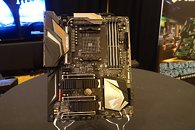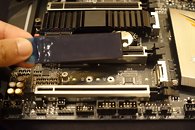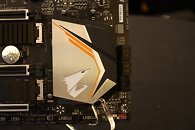- Joined
- Oct 9, 2007
- Messages
- 47,681 (7.42/day)
- Location
- Dublin, Ireland
| System Name | RBMK-1000 |
|---|---|
| Processor | AMD Ryzen 7 5700G |
| Motherboard | Gigabyte B550 AORUS Elite V2 |
| Cooling | DeepCool Gammax L240 V2 |
| Memory | 2x 16GB DDR4-3200 |
| Video Card(s) | Galax RTX 4070 Ti EX |
| Storage | Samsung 990 1TB |
| Display(s) | BenQ 1440p 60 Hz 27-inch |
| Case | Corsair Carbide 100R |
| Audio Device(s) | ASUS SupremeFX S1220A |
| Power Supply | Cooler Master MWE Gold 650W |
| Mouse | ASUS ROG Strix Impact |
| Keyboard | Gamdias Hermes E2 |
| Software | Windows 11 Pro |
We headed to the GIGABYTE Aorus booth at the 2018 International CES to check out the only motherboard based on AMD's upcoming 400-series chipset visible in the entire show, the Aorus X470 Gaming 7. We snapped a lot of pictures. The first thing that caught our attention is the board's updated styling, which resembles the one GIGABYTE introduced with its Intel Z370-series motherboards. The second thing of course, was two 32 Gb/s M.2 slots, confirming that AMD has indeed addressed 300-series chipset's greatest shortcoming - lack of PCIe gen 3.0 general purpose lanes. Since the AM4 SoC puts out 4 gen 3.0 general purpose lanes of its own, which wired to one 32 Gb/s M.2 slot on 300-series motherboards, the new 400-series boards will have at least two of these slots, one wired to the AM4 SoC, and another to the chipset.
The Aorus X470 Gaming 7 could become the company's flagship socket AM4 product based on AMD X470 chipset. It's been designed as such. Built in the ATX form-factor, the board draws power from a combination of 24-pin ATX, 8-pin EPS, and 4-pin ATX power connectors. A 12-phase VRM supplies power to the AM4 SoC. It's interesting to note that GIGABYTE chose some very high-current chokes for the chip's main voltage domains. The VRM heatsinks, too, are elaborate aluminium fin-stack types, with the two heatsinks spreading heat over a heat pipe. Is this a telltale sign that certain Ryzen 2 parts could have >95W TDP? The CPU socket is wired to four DDR4 DIMM slots, two PCI-Express 3.0 x16 slots (x8/x8 when both are populated), and one of the two M.2 slots (we're guessing the top M.2-22110 slot). Both it, and the bottom M.2-2280 slots have included heatsinks. Other expansion slots include an x16 (electrical x4) slot wired to the chipset, and two x1 slots, which are all gen 3.0.





Besides the two 32 Gb/s M.2 slots, the board offers six SATA 6 Gb/s ports. USB connectivity includes two USB 3.1 gen 2 ports (both on the rear panel, including a type-C port), ten USB 3.0 ports (six on the rear panel, and four by headers), of these two ports are designated "DAC-UP" ports for lower digital noise and latency to USB headsets or AMPs. It's extremely interesting to note that there are no visible display outputs on the rear panel, despite the fact that some AM4 chips, such as the "Raven Ridge" APUs, come with integrated graphics. Perhaps that USB 3.1 type-C port has DisplayPort routing.


Networking include 802.11ac, Bluetooth 4.1, and one gigabit Ethernet interface. GIGABYTE deployed a high-grade onboard audio solution, which combines a 120 dBA SNR CODEC, with a headphones amplifier that has a de-pop circuit, high-grade WIMA and Nichicon Muse capacitors, and ground-layer isolation.Being an Aorus Gaming product, the Aorus X470 Gaming 7 will be packed to the boot with RGB LED hardware, beginning with the RGB LED diffuser accentuating a corner of the board, and multiple RGB headers backed by GIGABYTE RGB Fusion software.





There's talk of an April 2018 launch for this board, alongside the first Ryzen "Pinnacle Ridge" processors, which this board supports out of the box. We expect it to be priced at USD $250.
View at TechPowerUp Main Site
The Aorus X470 Gaming 7 could become the company's flagship socket AM4 product based on AMD X470 chipset. It's been designed as such. Built in the ATX form-factor, the board draws power from a combination of 24-pin ATX, 8-pin EPS, and 4-pin ATX power connectors. A 12-phase VRM supplies power to the AM4 SoC. It's interesting to note that GIGABYTE chose some very high-current chokes for the chip's main voltage domains. The VRM heatsinks, too, are elaborate aluminium fin-stack types, with the two heatsinks spreading heat over a heat pipe. Is this a telltale sign that certain Ryzen 2 parts could have >95W TDP? The CPU socket is wired to four DDR4 DIMM slots, two PCI-Express 3.0 x16 slots (x8/x8 when both are populated), and one of the two M.2 slots (we're guessing the top M.2-22110 slot). Both it, and the bottom M.2-2280 slots have included heatsinks. Other expansion slots include an x16 (electrical x4) slot wired to the chipset, and two x1 slots, which are all gen 3.0.





Besides the two 32 Gb/s M.2 slots, the board offers six SATA 6 Gb/s ports. USB connectivity includes two USB 3.1 gen 2 ports (both on the rear panel, including a type-C port), ten USB 3.0 ports (six on the rear panel, and four by headers), of these two ports are designated "DAC-UP" ports for lower digital noise and latency to USB headsets or AMPs. It's extremely interesting to note that there are no visible display outputs on the rear panel, despite the fact that some AM4 chips, such as the "Raven Ridge" APUs, come with integrated graphics. Perhaps that USB 3.1 type-C port has DisplayPort routing.


Networking include 802.11ac, Bluetooth 4.1, and one gigabit Ethernet interface. GIGABYTE deployed a high-grade onboard audio solution, which combines a 120 dBA SNR CODEC, with a headphones amplifier that has a de-pop circuit, high-grade WIMA and Nichicon Muse capacitors, and ground-layer isolation.Being an Aorus Gaming product, the Aorus X470 Gaming 7 will be packed to the boot with RGB LED hardware, beginning with the RGB LED diffuser accentuating a corner of the board, and multiple RGB headers backed by GIGABYTE RGB Fusion software.





There's talk of an April 2018 launch for this board, alongside the first Ryzen "Pinnacle Ridge" processors, which this board supports out of the box. We expect it to be priced at USD $250.
View at TechPowerUp Main Site


